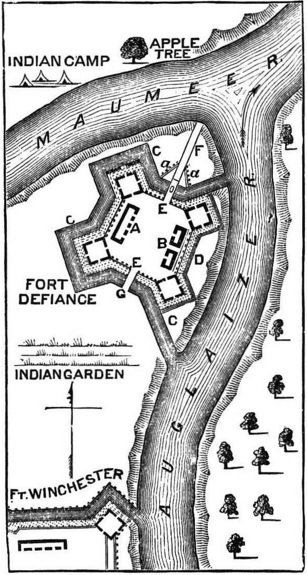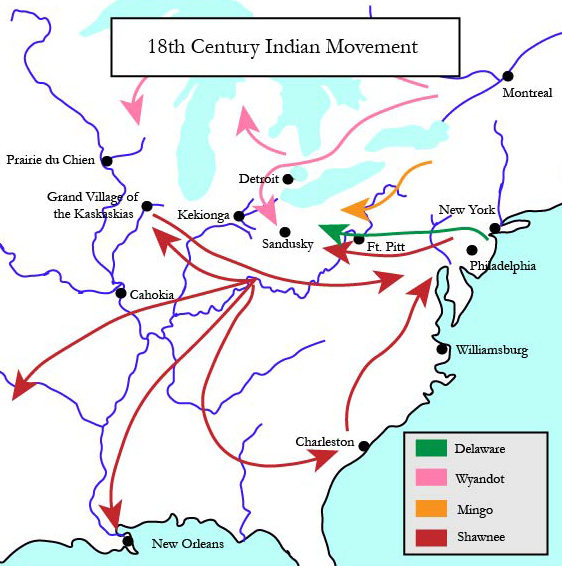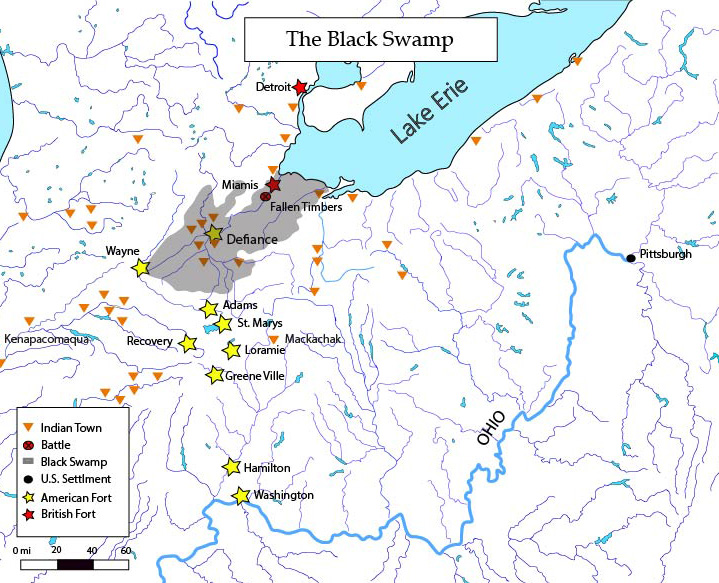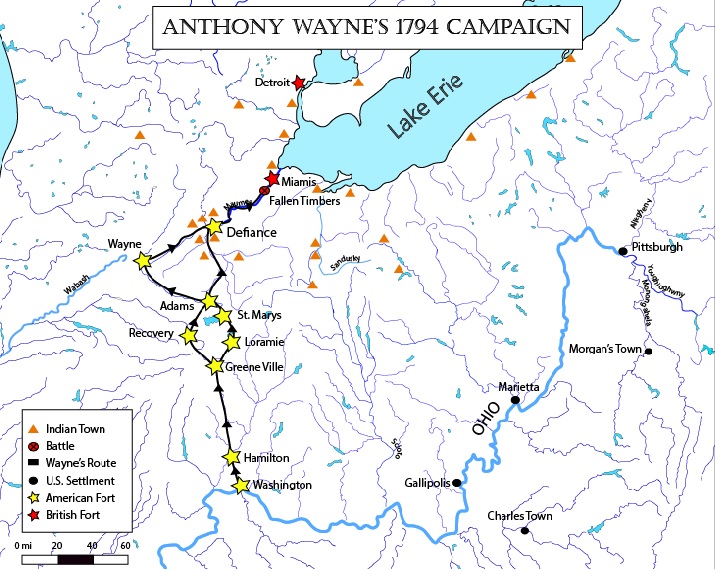History of Fort Defiance
Located at the confluence of the Maumee and Auglaize rivers in northwestern Ohio is the former site of Fort Defiance. Although little remains of the original structure, it once played a crucial role in the history of American settler colonialism. Built in 1794 during Anthony Wayne’s campaign against a coalition of Indigenous nations of the Ohio Country, Fort Defiance played a decisive role in American victory. In addition to serving as a base of operations for the Battle of Fallen Timbers, the construction of Fort Defiance placed pressure on the British government in Canada to make a definitive decision concerning their support of their Indian allies. The construction of the fort also had a significant impact on the regional Indigenous population. During the American construction and occupation of the fort, Wayne destroyed the numerous fields of crops that the coalition depended on. The combination of these different factors resulted in the British abandoning their Indigenous allies and the coalition agreeing to the terms of the Treaty of Greenville in 1795.

during the War of
1812. From Benson
J. Lossing’s Pictoral
Fieldbook of the
War of 1812.
The Struggle for the Old Northwest
Following the American Revolution, fighting continued between the United States and the numerous Indigenous nations in the area known as the Old Northwest. American settlers, land speculators, and politicians wanted to expel the Native Americans from the region and take their land. They were willing to accomplish this by force if necessary. When treaty negotiations failed, the United States launched several campaigns into the region by Josiah Harmar (1790) and Arthur St. Clair (1791). These campaigns ended in disaster for the Americans. Blue Jacket and Little Turtle successfully forged a coalition between members of the Shawnee, Wyandot, Mingo, Miami, Lenape (Delaware) and other nations. This coalition defeated the American forces handily. What would be referred to as St. Clair’s Defeat was the most one sided defeat in American military history. In response to these embarrassing loses, President Washington appointed General “Mad" Anthony Wayne to lead a newly christened Legion of the United States.
In the fall of 1794, Wayne led his Legion into northwestern Ohio with the intent of forcing the Indians to cede land to the invading American settlers. At this time, there were several major Native American population centers in the region. One such concentration was located at the confluence of the Maumee and Auglaize rivers. Known as the Miami Towns or the Grand Glaize, this cluster of villages became a military objective for Wayne.

Created by Joshua Catalano.
The Grand Glaize
Centuries of warfare, trade, and migration created plural communities, such as The Grand Glaize, across the interior of the North American continent (Figure 2). These communities were comprised of individuals from numerous nations, clans, and communities as well as descendants of French and British traders. The Grand Glaize itself became a permanent settlement during the American Revolution and grew in importance during the 1780s and early 1790s. Part of what made the Grand Glaize an attractive location was the fertility of the soil. An American soldier upon seeing the region commented on the land’s fertility:
This place far excels in beauty any in the western country, and believed equaled by none in the Atlantic States. Here are vegetables of every kind in abundance, and we have marched four or five miles in cornfields down the Oglaize, and there is not less than one thousand acres of corn round the town. The land in general of the fir nature.[1]
The region’s agricultural production was very important to the local Native American population and did not go unnoticed by Wayne who referred to the region as the “the grand emporium of the hostile Indians of the west.”[2]

Finally, the Grand Glaize was also protected by a natural barrier known as the Black Swamp (Figure 3 ). The region of wet marshland made land travel difficult especially for heavy military convoys. Wayne and his men would have to construct bridges and maneuver their way around the boggy soil. One such bridge was “seventy yards in length” and would “require infinite labor” for the bottom ground was “a perfect Mud.”[3] In addition to soft soil, Wayne and his men were also faced with an abundance of mosquitoes and a lack of safe drinking water. One soldier, John Boyer, found the mosquitoes to be “very troublesome, and larger than [he] ever saw.”[4] While crossing the Black Swamp, the American soldiers found “no water except in stagnant pools and in the Bed of a small branch, which is foul and disagreeable to the taste.”[5] These factors made the Grand Glaize a bountiful refuge within a swampy hell.
Wayne’s Invasion

In order to achieve the settler-colonial ambitions of the United States, Anthony Wayne partook in a psychological and symbolic war for Ohio. Both the Legion and the Indigenous coalition used various techniques including purposeful acts of violence, ritual, naming practices, and fear tactics among others. Psychological and symbolic considerations influenced where, when, and how engagements were fought. Part of Wayne’s strategy was to construct a series of forts stretching into the heart of the coalition's homeland (Figure 4). Wayne cautiously and methodically advanced northward until he secured The Grand Glaize. Here Wayne constructed Fort Defiance. A stucture “sufficient to resist a twenty four pounder.” Legend has it that the name of the fort came from a conversation between Wayne and one of his fellow commanders. In this likely fictional conversation Wayne or his subordinate stated that they “defy the English, Indians & all the devils in hell to take it.” Evidence of the conversation has never surfaced but has lived on in legend. Regardless, the fort was a formidable fortress that upset the power dynamic in the region.
“I defy the English, Indians & all the devils in hell to take it.”While at this location Wayne plundered the Native American coalition's fields and burned what resources his Legion could not consume. Eventually Wayne made his way downriver where he defeated a Native American force at the Battle of Fallen Timbers. Faced with the possibility of renewed warfare with the United States, the British closed the gates of Fort Miami in front of their fleeing Indigenous allies. Starving and recognizing the unreliability of the British, the Indigenous coalition negotiated the Treaty of Greenville with the United States in 1795. This treaty guaranteed American access to the region, but allowed the Native nations to retain their land in Northwest Ohio. The Americans were satisfied with their land grab and the Indigenous nations survived to fight another day. For more on this campaign, please see "Blue Jacket, Anthony Wayne, and the Psychological and Symbolic War for Ohio, 1790–95", an open access journal article in Ohio History published by Kent State University Press.
~Unknown
The End of Fort Defiance
Following Wayne’s campaign, the United States occupied Fort Defiance for a number of years before the wooden structure began to rot. During the War of 1812, the region again became strategically important. The United States made repairs to the crumbling fort but ultimately decided to construct Fort Winchester just a short distance away. As the years passed, the remnants of Fort Defiance deteriorated and became a memory of a violent and painful history. Today, visitors can walk around the remains near the public library in Defiance, Ohio and learn about the local history.
References
[1] Journal of John Boyer, August 7, 1794. Reprinted in The American Pioneer, 316.
[2] Wayne to Knox, August 14, 1794. Papers of the War Department.
[3] Journal of John Boyer, July 31, 1794, Reprinted in The American Pioneer, 315; Randolf Journal, July 31, 1794, reprinted in American Antiquarian Society, 281.
[4] Journal of John Boyer, July 30, 1794, reprinted in The American Pioneer, 315.
[5] Unidentified Journal, August 4, 1794, "From Greene Ville to Fallen Timbers," edited by Dwight L. Smith, in Indiana Historical Society Publications, XVI, 263.
